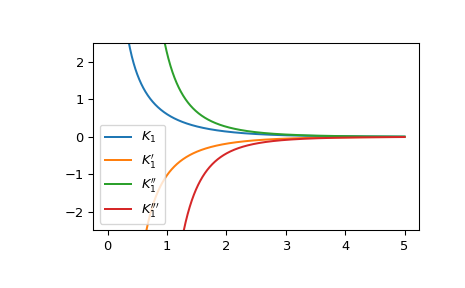kvp#
- scipy.special.kvp(v, z, n=1)[source]#
Compute derivatives of real-order modified Bessel function Kv(z)
Kv(z) is the modified Bessel function of the second kind. Derivative is calculated with respect to z.
- Parameters:
- varray_like of float
Order of Bessel function
- zarray_like of complex
Argument at which to evaluate the derivative
- nint, default 1
Order of derivative. For 0 returns the Bessel function
kvitself.
- Returns:
- outndarray
The results
See also
Notes
The derivative is computed using the relation DLFM 10.29.5 [2].
References
[1]Zhang, Shanjie and Jin, Jianming. “Computation of Special Functions”, John Wiley and Sons, 1996, chapter 6. https://people.sc.fsu.edu/~jburkardt/f77_src/special_functions/special_functions.html
[2]NIST Digital Library of Mathematical Functions. https://dlmf.nist.gov/10.29.E5
Examples
Compute the modified bessel function of the second kind of order 0 and its first two derivatives at 1.
>>> from scipy.special import kvp >>> kvp(0, 1, 0), kvp(0, 1, 1), kvp(0, 1, 2) (0.42102443824070834, -0.6019072301972346, 1.0229316684379428)
Compute the first derivative of the modified Bessel function of the second kind for several orders at 1 by providing an array for v.
>>> kvp([0, 1, 2], 1, 1) array([-0.60190723, -1.02293167, -3.85158503])
Compute the first derivative of the modified Bessel function of the second kind of order 0 at several points by providing an array for z.
>>> import numpy as np >>> points = np.array([0.5, 1.5, 3.]) >>> kvp(0, points, 1) array([-1.65644112, -0.2773878 , -0.04015643])
Plot the modified bessel function of the second kind and its first three derivatives.
>>> import matplotlib.pyplot as plt >>> x = np.linspace(0, 5, 1000) >>> fig, ax = plt.subplots() >>> ax.plot(x, kvp(1, x, 0), label=r"$K_1$") >>> ax.plot(x, kvp(1, x, 1), label=r"$K_1'$") >>> ax.plot(x, kvp(1, x, 2), label=r"$K_1''$") >>> ax.plot(x, kvp(1, x, 3), label=r"$K_1'''$") >>> ax.set_ylim(-2.5, 2.5) >>> plt.legend() >>> plt.show()
